 by David Otte
by David Otte
Thanks to technological advances in our hobby, there are a number of options the consumer should consider when purchasing an electric model train starter set. As an example, Bachmann’s current selection of HO-scale starter sets can be broken down into several groups: standard diesel or steam locomotive powered consists accompanied by a traditional analog direct current (DC) transformer; “E-Z App” sets allowing the train to be controlled wirelessly from any Bluetooth enabled Android or Apple touchscreen device; Bachmann’s “DCC on Board” sets, providing the novice model railroader the ability to enter the Digital Command Control (DCC) arena via a factory-installed motor decoder in the locomotive; and DCC “Sound Value on Board” releases that include not only a locomotive so equipped, but Bachmann’s E-Z Command Control Center to boot.
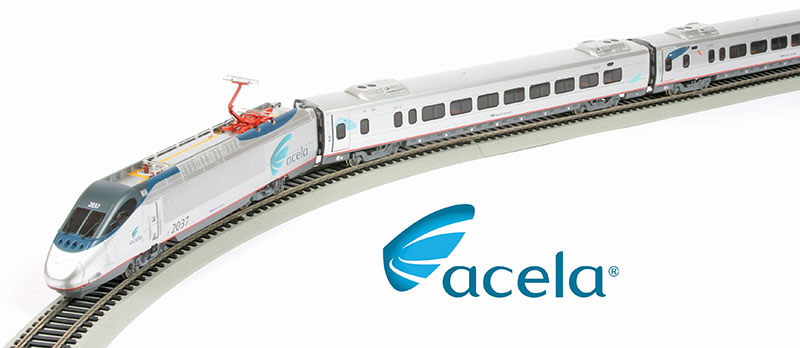
The premise behind Amtrak’s Acela service dates back to the High Speed Ground Transportation Act of 1965. Part of Lyndon Johnson’s Great Society infrastructure building initiative, the President remarked as he signed the bill into law, “. . . An astronaut can orbit the earth faster than a man on the ground can get from New York to Washington. Yet, the same science and technology which gave us our airplanes and our space probes, I believe, could also give us better and faster and more economical transportation on the ground. And a lot of us need it more on the ground than we need it orbiting the earth . . . so, we must find ways to move more people, to move these people faster, and to move them with greater comfort and with more safety.” As a direct result, the Office of High-Speed Ground Transportation was formed within the Department of Commerce (the Department of Transportation would not be created until October 1966) to oversee the implementation of high speed projects – most notably Metroliner service between the highly traveled 225-mile-long New York to Washington, D.C., electrified rail corridor.
With initial round trips beginning in 1969 and performed in less than three hours, the Budd-built tubular shaped stainless steel Metroliner self-propelled multiple-unit electric cars were quickly hailed a success. Unfortunately, weaknesses in the design of several key components of the propulsion system came to light shortly thereafter, which caused the Metroliner to be notoriously unreliable. As a result, the service was pretty much discontinued by 1981 in favor of slower but more dependable electric locomotive hauled conventional consists. In the early 1990s, however, strong interest in high-speed trains for the Northeast Corridor (NEC) resurfaced and Amtrak invited builders from around the world to submit new equipment designs.
Ultimately, only three companies made proposals. Asea Brown Boveri (ABB) submitted its X2000 (originally designed for Swedish State Railways) and Siemens offered its InterCity Express (ICE) trainset (similar to trains operating extensively in Germany). Unlike contemporary French and Japanese high-speed equipment, though, these two designs did not require new dedicated tracks, but achieved maximum speeds between 155 and 165 mph through the use of advanced electric propulsion systems that permitted faster acceleration, radial self-steering trucks for aiding the train to steer through tight curves, and tilt technology that allowed the cars to lean into curves while keeping passengers in comfort. Tested on the Corridor between Washington, D.C., and New Haven, Conn., from 1992 through 1993, both modern looking trains were a big hit with the general public. The third and final competitor for Amtrak’s new high-speed train was the team of Canadian firm Bombardier and France’s Alstom (maker of the French TGV). Referred to as the “American Flyer,” the consortium’s proposal wasn’t necessarily the best design (the X2000 in particular had been the popular favorite among the U.S. public), but it did offer the most bang for the buck from the perspective of a financially strapped Amtrak. In the end, Bombardier-Alstom received the contract in March 1996.
In preparation for the new service, which Amtrak re-branded Acela in March 1999 — a combination of the words “acceleration” and “excellence” — Congress not only authorized funding for 20 complete trainsets (Amtrak actually owns only one Acela set outright with the other 19 trains leased), but for infrastructure improvements as well, most notably the “Northend Electrification Project.” This effort saw the extension of existing electrification from New Haven, Conn., to Boston, Mass., to complete the overhead power supply along the entire 457-mile-long Northeast Corridor, and improvement or removal of several grade crossings along the route to minimize speed restrictions. Although some initial teething problems discovered during testing delayed the planned late 1999 introduction of the Acela Express, the new trainsets finally began entering revenue service on December 11, 2000. Each Acela is made up of eight semi-permanently coupled rail vehicles stretching a total of 665 feet 9 inches in length — four Business Class cars, a Cafe car, and a First Class car, all sandwiched between two power cars. Each power car is rated at 6,200-hp and operates on 11,000 volts alternating current (AC) at either 25 or 60 Hertz frequency. Each car has a maximum tilt capability of 6.5 degrees, while the trainset’s minimum curve radius is 250 feet. Total passenger capacity is 304 with 44 seats in First Class and 260 situated in Business Class. Designed for a maximum speed of 165 miles per hour, the Acela Express is limited to 150 miles per hour on the NEC, although even this speed is only possible on about 34 miles of the route. Nevertheless, with limited intermediate stops, these trains can travel between New York City and Washington, D.C., as fast as 2 hours 45 minutes (average speed 82.2 miles per hour) and between Boston, Mass., and New York City in 3 hours 30 minutes (average speed 66 miles per hour). So, traveling the entire NEC run (approximately 450 miles) on Acela can be done in about seven hours. Amtrak’s Acela service remains quite competitive with available airline shuttle flights and these high-speed trains have aided Amtrak in capturing an impressive 75 percent of the region’s total commuter business. In fact, ridership on the express service has risen from 2.5 million passengers in 2002 to 3.4 million in 2018, greatly exceeding Amtrak’s projected growth of the service when it first planned the Acela back in 1996.
Like the old Budd Metroliners, the Acela, one of the world’s heaviest high-speed trains, has had its fair share of design flaws that have needed to be addressed along the way. The most serious perhaps was the discovery of cracks in the train’s disc brakes in April 2005, which subsequently prompted all 20 trainsets to be taken out of service and express business handed over to conventional passenger trains. The manufacturer replaced the brakes under warranty and limited operations resumed beginning in July 2005 with all 20 trainsets back in service by September of that year. Because Amtrak management chose a relatively unique design for its high-speed train over a proven “off-the-shelf” model, as those offered by ABB and Siemens in the early 1990s, such mechanical challenges must be resolved by Amtrak personnel and Bombardier-Alstom alone, as the problems arise.
It is in the spirit of this revelation that Amtrak in 2012 decided not to order additional Acela cars in an effort to increase capacity of its popular train and instead sought funding for entirely new equipment. In August 2016, a $2.45 billion federal loan package was announced to pay for 28 “Acela 21” sets, as Amtrak planners refer to the next generation trainset program. This would allow for increased daily express train service, a 30 percent increase in seating capacity, and utilize an active tilt technology that could see operating speeds as high as 186 miles per hour — provided additional improvements are made to the NEC infrastructure. Quickly following the announcement, Amtrak placed an order with Alstom for what is being called the Avelia Liberty trainset, which is based on the builder’s proven Avelia platform design currently operating in France and Italy. The 28 trainsets with their nine passenger cars, two power cars, and 380 seating capacity each are being assembled at Alstom’s plants in Hornell and Rochester, N.Y. They should see delivery during 2021 and 2022, at which point the old Acela trainsets will be retired for good.
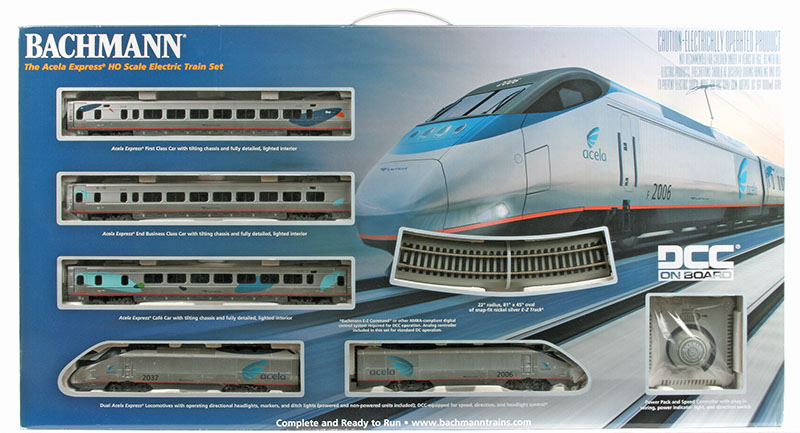
As a member of Bachmann’s high-end Spectrum product line, this HO-scale Amtrak Acela Express isn’t just another starter train set. The set features an accurate scale reproduction of Amtrak’s Acela prototype. Interestingly, Bachmann’s HO-scale set has actually been cataloged as long as the real Acela has been in revenue service, with the 1:87 rendering having made its debut in time for the holiday season in 2000. At the time, the consist was only a DCC-ready operation, but for 2019, Bachmann is now providing the lead power car with its DCC on Board decoder and the entire consist with a freshened-up paint job to boot.
Now, it should be noted from the start that the set’s consist is an abbreviated version of the real train — only three passenger cars are included instead of the prototype’s six. First and foremost, the reduced rolling stock keeps the starter set as affordable as possible for the budding railroader while also giving the more experienced modeler examples of each car type on the Acela roster: First Class, Cafe, and Business Class End Car. Even shortened, however, the assembled consist still measures an impressive 56 inches, so this starter set is not for those folks planning on building a very small layout. In fact, if one were to add the additional cars Bachmann has announced for a first quarter 2020 release, Business Coach (#89945), a second Business Coach (#89946), and Quiet Car (#89947), to complete the HO-scale Acela consist, the trainset will stretch to nearly 92 inches in length!
As the Acela consist is the star attraction of this Spectrum starter set, let’s get down to its nuts and bolts. Looking back at Bachmann’s announcement of the impending set in late 1999, the HO Acela Express was advertised as an officially Amtrak licensed venture from the get-go. The passenger rail carrier provided builder’s diagrams to the hobby company to ensure its proper execution. As such, each component of the HO-scale train exhibits dimensions closely following those of the prototype: the power cars’ (as the two locomotives are referred to) 69 feet 7 inch length (excluding the diaphragms), the passenger cars’ 87 feet 5 inch length (over the diaphragms), and an overall maximum width for all car types of 10 feet 5 inches. Finally, the power cars ride atop the correct scale 40-inch diameter wheels and the passenger cars mimic their real world counterparts’ scale 36-inch diameter wheels.
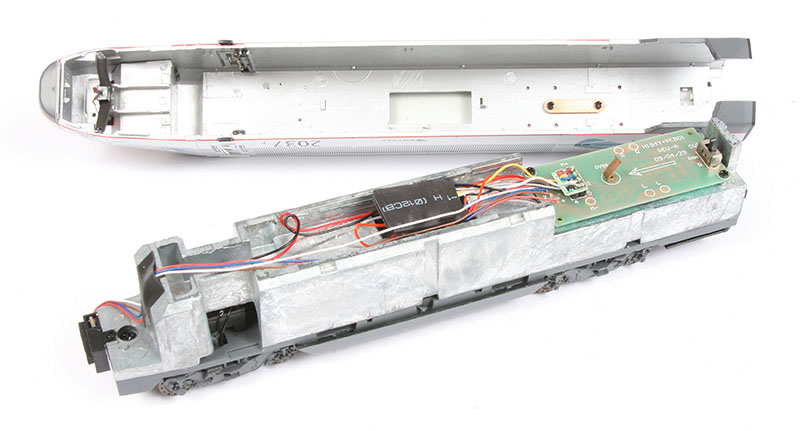
Both power and passenger cars feature one-piece injection-molded plastic bodies that capture well the aerodynamic profile of the prototype, along with the proper placement of window openings and doors, prominent hood side grilles of the power cars, fine ribs running lengthwise atop the roofs, and the structural battens (both above and below the windows) stretching down the sides of the passenger cars. In addition, the power cars are enhanced with separate nose and front air dam, an equipment box located between the trucks, and end plates with add-on diaphragms. In addition, the crew doors on either side of the cab can actually be opened by the modeler, although, admittedly, it’s really more of a gimmick since there is nothing in the cab that could be seen through such a small opening anyway. On the other hand, the other detail parts applied by the manufacturer are quite beneficial and include windshield wipers, accurate truck sideframes with wheels exhibiting the proper hole pattern on their faces, and stirrup steps below the cab doors. While the cab windshield and side glass is flush-fitting, just like the real power cars, their heavy tinting distracts the modeler from the fact that the cabs lack an interior of any kind — just internal view blockers. It is on the roof where Bachmann makes the most effort on these power cars. Note the various insulators and electrical conduit runs, equipment boxes, roofline shrouds, and metal lift rings at the rear edge of the roof. The pairs of directional metal pantographs are quite an assembly in and of themselves. Each is made up of about a dozen pieces, including real springs, so that the operator can raise and lower them as desired. In fact, beneath a small hatch to the rear of the pantographs, one will find a micro slide switch that allows the power cars to actually operate from catenary, just like the prototype, but more on that later.
Likewise, the passenger cars reflect many of these same attributes, such as the flush-fitting window glazing with simulated black gaskets, car end diaphragms, well-detailed trucks, and underbody enclosures. One will also notice photo-etched fan grilles incorporated into the equipment blisters on either end of the car roofs, with additional air intake vents situated along the sides of the humps. In contrast to the power cars, the Business Class, First Class, and Cafe cars each display full unique interiors. As appropriate for each prototype, various styles of seating, tables, stools, and service counters can be seen inside, all molded in blue or orange plastic. To better appreciate the effort Bachmann has made with its passenger cars, the company provides interior lighting featuring LEDs, which are track powered via the insulated metal wheel sets in each truck and the phosphors bronze wiper arms that come into contact with the backs of the wheels. The power cars have some cool LED-equipped lighting effects too, including directionally controlled headlights, rear end marker lights, and ditch lights.
Besides its sleek aerodynamic silhouette you see, while this train is speeding down the NEC, the second most eye-catching feature of the real Acela Express is undoubtedly the paint scheme it wears. Bachmann captures this dress perfectly on its HO-scale rendering. To better appreciate the effort made here, some background information regarding the decoration of the prototype will be helpful. The first detail that has always stood out to me is the Acela logo itself. Although it wasn’t clear to me at the time I first observed it, apparently the symbol adorning the sides of the power cars “is an abstraction of a sea turtle’s fin, instilling stately and peaceful progress through blue waters,” according to the Amtrak Livery and Logo Guide. Furthermore, when applied to the power cars only, the orientation of the fin symbol always faces toward the nose of the locomotive, as is properly depicted on this Bachmann Spectrum model.
While the logo was a bit of a mystery to me, I never realized until studying the Bachmann set just how complex the color choices were nor did I appreciate the significance of the graphics found on the car sides. Basically, the paint application begins with an overall coat of Platinum Mist (except over any stainless-steel body panels) with the underbody painted Anthracite Gray. Amtrak Blue is then applied to the nose and roofline of the power car, along with dark gray and black around the windshields, and the entire consist receives Amtrak Red sill stripes. Amtrak would use a very similar arrangement on its non-Acela equipment starting in 2000, which is better known to railfans as the road’s “Phase V” paint scheme.
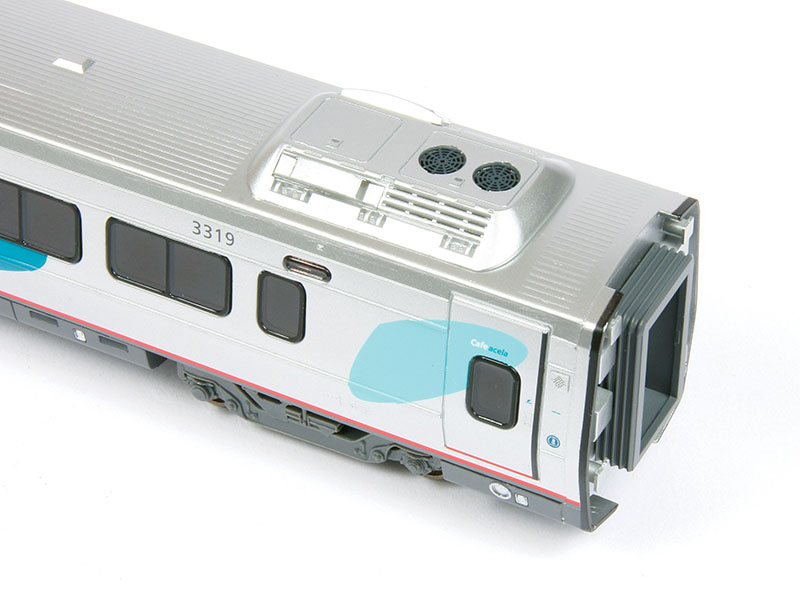
ABOVE: The cars boast good details, such as the photo-etched fan grilles and add-on vent scoops on the rooftop blisters, car end diaphragms, simulated gaskets running around the tinted window glass, and the molded-in roof ribbing and car side battens. Cafe Car 3319 is one of 20 such cars operating on the Acela Express. If you’re curious about those colored shapes randomly placed on the sides of the passenger cars, the hues signify car service type.
The strange colored “blobs” appearing on the passenger cars, though, are the most puzzling to me, but per Amtrak’s guide book, these shapes are based on the outline of the Acela logo and are called “mobiles.” The Acela mobiles actually serve a real purpose by indicating to crews and passengers alike the specific class or service of the car before them. For example, a combination of mobiles in blue, dark blue, and orange signifies Acela First Class; Amtrak Blue and medium blue or light blue are used on Business Class; and Amtrak Blue and Green mobiles indicate the Cafe car.
Although a sea turtle’s fin would never have come to my mind when reflecting on a symbol for a high-speed passenger train, it’s all pretty neat to consider when reflecting on Bachmann’s well-decorated trainset. The quality of the pad printing can especially be seen in the smallest of graphics applied, such as the handicap entrance symbols next to the car doors or the minute Amtrak “Travelmark” logo on the nose of the power cars. Speaking of that symbol, when the Acela Express first debuted, Amtrak was still using its “Wordmark” logo in red on the nose and sides of the power car as well as on the sides of the passenger cars, which is apparent on Bachmann’s Acela set offerings through 2018. For this latest release, however, the hobby manufacturer followed current Amtrak practice and updated its entire HO-scale consist with the Travelmark logo.
Likewise, the 2019 offering also boasts different road numbers from the initial set release of almost two decades ago. The power cars are now numbered 2006 and 2037, while First Class is 3209, the cafe 3319, and the Business car is 3410. So, if you already own an older Acela set, here is your chance to add a second uniquely numbered trainset to your modern passenger train roster. Just for reference, Acela equipment is grouped into five number series: power cars are 2000–2039; First Class cars 3200–3219; Cafe cars 3300–3319; Business Class End cars (which have a slightly altered interior plan from the mid-train Business Class cars) 3400–3419; and Business Class cars 3500–3559. In turn, Amtrak has assigned each of these cars to a specific trainset numbered 1–20.
Now, it’s this very fact that the Acela Express is a semi-permanently coupled trainset that leads us to the next facet of the Bachmann offering to study — the coupling mechanisms. Whereas a conventional passenger train would use knuckle couplers, this prototype is draw-barred together. The challenge for Bachmann then was to not only replicate the linkage style, but also maintain the close coupling of the real high-speed consist while operating on typical HO radius curves. The company’s solution was to utilize a sprung draft box, which is mounted to the chassis of the power and passenger cars.
The drawbars are basically plastic fork-shaped pieces that come in two lengths, with the shorter version used between the power car and passenger car and longer version used strictly between passenger cars. The drawbars snap into the corresponding draft boxes and are equally easy to pull back apart when disassembling the consist. The only drawback I found with this system is that the sprung draft boxes on the passenger cars are recessed from their ends, which makes them rather difficult to see during the coupling process. I first tried to align the cars on a long section of straight track and push the cars together, but with the boxes being sprung and able to move slightly, this method proved a bit frustrating. A more workable method is to lay individual cars on their sides next to a straight section of track, which offers a view of the bottom of the cars during coupling, and then slowly rotate the consist as one unit up onto the track.
Note that the plastic drawbars look somewhat delicate, but they do seem to hold up well if one does not try to handle the coupled consist too much; always disassemble the trainset first before lifting the models back off the rails. In fact, after 20 years on the market, the only real complaint I’ve heard from existing owners of this Bachmann set is the delicate nature of the drawbar system. Their advice is always the same: if you leave the trainset on the tracks and never try to move it by hand, you will have no problems with the coupling system. Regardless, Bachmann does include several additional short and long drawbars with the starter set, so the modeler always has a second chance if there is a coupling mishap the cars may encounter on their pike!
For powering the miniature Acela, the manufacturer has outfitted its powered Power Car unit with a twin brass flywheel equipped 5-pole can motor, all wheel drive and electrical pickup, and a heavy die-cast metal interior weight. The main circuit board is situated on top of the weight and features an 8-pin decoder plug, into which the DCC on Board decoder is plugged, a sprung pantograph contact plate, and the afore mentioned selector switch for choosing between overhead or track power operation. An additional lighting circuit board is then situated in the nose area and provides the previously described lighting effects. If you do decide to run the HO-scale Acela via catenary, remember to also switch to that option on the non-powered Power Car as well, so that its directional lighting features will correspond to those in the powered unit.
Before testing our sample, I took a moment to set up of the included 81 x 45 inch oval of gray colored roadbed E-Z Track and plugged in the power supply and controller (for more information on this aspect of the Bachmann starter sets, please see the other reviews for this manufacturer in this issue). Note that the 22-inch radius curves making up this simple layout are the suggested minimum on which the Acela Express should be operated. Also, while the included track features Code 100 size rail, the RP25 contour wheels on the cars do allow for operation on track down to Code 70 rail. As this prototype is designed to operate as a trainset, all my testing described below reflects the entire consist coupled together.
The 16 volts direct current and 16 volt-amps of power supplied by the controller appear to be adequate for operating the HO-scale Acela in analog fashion, with minimum consistent train movement commencing at about 6 volts and the lighting effects visible on the power cars beginning at about 8 volts. The heavy tinting of the passenger car windows, however, didn’t allow the interior lighting to become all that noticeable until reaching practically 12 volts. Meanwhile, advancing the throttle to this setting saw the trainset reaching scale speeds of about 120 miles per hour, which mimicked the prototype nicely, including the slight tilting of the passenger car bodies, and without the train derailing even once on curves. Even so, I frankly didn’t feel comfortable maintaining this high speed on this tight of a radius. I would strongly suggest to the potential purchaser of this set to use larger curves if at all possible, if planning to operate this train at prototypical speeds!
Moving the 1:87 Acela from the novice starter set layout to a DCC equipped layout affords the more experienced modeler even better performance. While we generally do not include a By the Numbers chart in train set reviews due to their cost-effective features, Bachmann’s Acela Express is after all a Spectrum model and warrants such attention. Under the command of a Digitrax (digitrax.com) Zephyr Command Station, the Acela’s scale speed ranged from just a hair over 1 mile per hour to a maximum, as allowed by the decoder’s factory settings, of 112 miles per hour. Very smooth operation overall and the gear train of the powered Power Car was pretty silent. Another benefit of DCC operation is that the passenger car’s interior lighting, under the constant 14-16 volts being applied to the track, was nice and bright at all times. Sadly, there is no decoder guide included within the set’s paperwork to aid the novice DCC operator, but the DCC on Board decoder is National Model Railroader Association (NMRA) compliant and appears to have all the basic control and programming features one would expect.
It’s worth mentioning that the lighting system’s associated electrical pickup wipers contacting the back of the passenger car wheels do produce some noticeable friction, which, in turn, requires a rather robust locomotive in order to pull a potential full eight-car consist. Luckily, the powered Power Car in this set, which weighs in at a hefty pound-and-a-half, is definitely up to the challenge, as my drawbar testing of just the electric locomotive alone resulted in an impressive pull of 5.5 ounces. Better yet, no traction tires are necessary in obtaining this outcome. So, bottom line, if the Acela Express appeals to you, don’t hesitate to add the other three cars Bachmann is selling separately for this set; a true eight-car consist on one’s modern pike would be quite a sight!
Having done some research on the real Acela at the outset of this review, I now have a better appreciation for Amtrak’s high-speed train concept, where acceleration and excellence come together to serve the NEC traveler. Likewise, I think the same can be said of Bachmann’s Acela Express starter train set. The acceleration can be seen in the power and performance of the HO scale locomotive/passenger equipment while there is excellence in the overall execution of the consist. Despite its train set label and leanings toward the beginner, this Spectrum level model is definitely worthy of the more serious modern railfan’s attention too.
Bachmann Trains
1400 East Erie Avenue
Philadelphia, PA 19124
800-356-3910
bachmanntrains.com


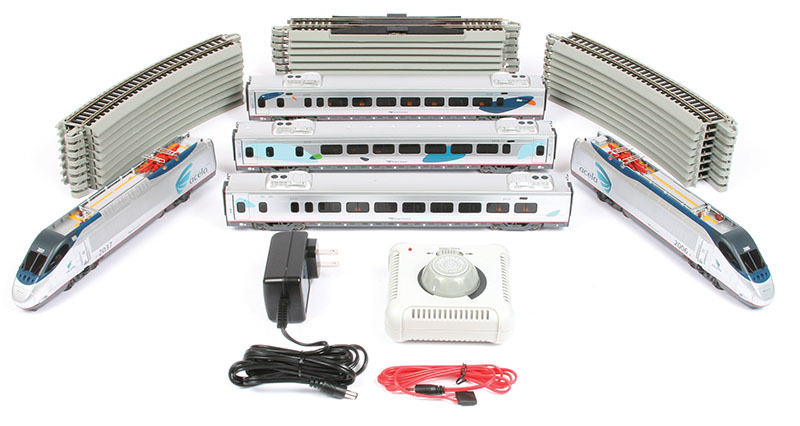
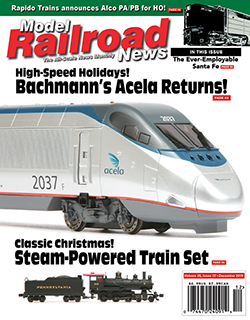 This review appeared in the December 2019 issue of Model Railroad News!
This review appeared in the December 2019 issue of Model Railroad News!